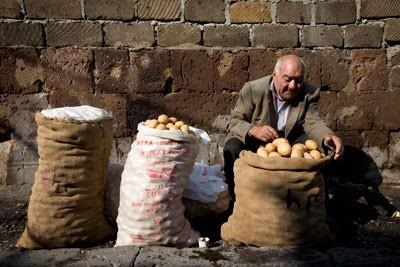Countries buck hunger trend with right policies
November 11 2009, Rome – Rising global hunger figures mask the fact that 31 out of 79 countries monitored by FAO have registered a significant decline in the number of undernourished people since the early nineties.
A report published today—entitled Pathways to Success—highlights the progress made by 16 of these countries that have already achieved the target of halving the number of hungry by 2015 or are on track to do so.
The number of hungry people is currently at an historic high of 1.02 billion. More than 60 heads of State and Government have confirmed their travel to Rome for the World Summit on Food Security to be held on November 16, 17, 18 to discuss strategies for boosting agricultural production and eradicating hunger.
The FAO paper, presented by the FAO Director General Jacques Diouf, analyses in detail factors underlying the success of four countries that have reduced hunger significantly: Armenia, Brazil, Nigeria and Vietnam.
Online campaign
Diouf said the report, “through the examples it offers, provides a message of hope—the battle against hunger can be won. What is required is an unwavering commitment from developing country governments themselves and strong support from the international community.”
Diouf also launched an online anti-hunger campaign, calling on the general public to sign a call for eradicating hunger. The petition can be signed by logging on to the website www.1billionhungry.org.
Common denominators
According to the FAO Pathways to Success report, there are four common denominators that make hunger reduction successful: the creation of the right environment promoting economic growth and personal wellbeing; investment in the rural poor and outreach to the most vulnerable; ensuring achievements are maintained and safeguarded against threats; planning for a sustainable future.
For example, with regard to reaching out to the most vulnerable and investing in the rural poor, in 2003 the Brazilian Government introduced a Zero Hunger strategy.
The Government mobilised local authorities and civil society organisations to support the strategy, which involved funding cash transfers to increase the purchasing power of the poor whilst at the same time investing in family farming.
The approach created demand and supply simultaneously, for the benefit of all.
“Rapid reduction in the prevalence of undernourishment ensued,” the FAO paper said.
Nigeria’s National Programme for Food Security succeeded in more than doubling production and incomes of small farmers who practice rain fed agriculture by introducing improved technologies that enabled them to grow two or three crops each year instead of just one.
Protecting gains
Viet Nam is cited an example of a country that is careful to protect what has already been achieved if that achievement is threatened by diseases or natural disasters. The paper shows how, when the SARs virus threatened, the country quickly reorganized the way business was done in the poultry sector and strengthened veterinary services to prevent that and future animal-borne diseases from turning into serious human epidemics.
Looking to the future, the Government of Armenia has accorded high priority to investments in upgrading its rundown water delivery infrastructure. At present, “the current irrigation system transfers water with more than 50 percent losses,” according to the report.
In addition to the four countries mentioned above, the FAO paper also examines how three other developing countries – Algeria, Malawi and Turkey - transformed their agriculture sectors into important sources of growth and export earnings which in turn contributed to poverty and hunger reduction and to making global food supplies more secure.
Smallholders key
The paper also concluded that one of the most economical and best pathways out of rural poverty and hunger is to support smallholder farmers. Around 85 percent of the world’s farms are smaller than two hectares and smallholder farmers and their families represent two billion people, or one-third of the world’s population.
Indonesia, Mexico and Sierra Leone are examples of countries that have developed innovative approaches to empowering and supporting smallholders.
Emergency assistance may still be required in some of the countries where under nourishment has decreased, especially those that started out with a high proportion of the population suffering from hunger.
